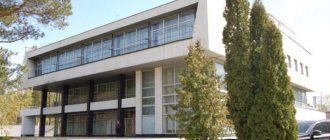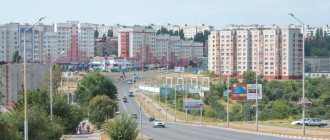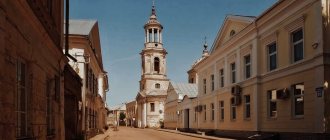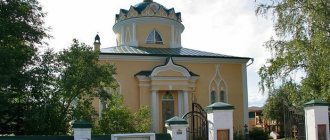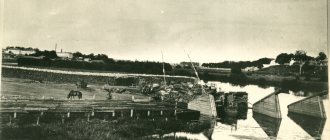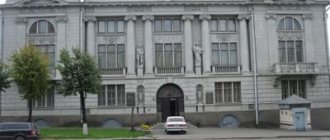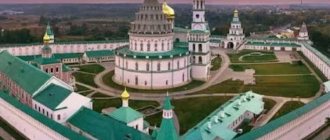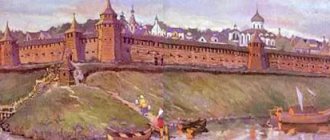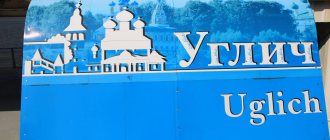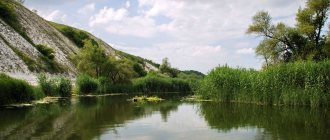Dubna
(until 1958 -
Dubno
), a city of regional subordination in the Moscow region, within the Dubna-Taldom deanery of the Sergiev Posad diocese. Located in the northernmost point of the Moscow region, on the banks of the Volga River, bounded by the Dubnaya and Sestra rivers, the Moscow Canal and the Ivankovsky Reservoir, 125 km from Moscow. The only settlement in the Moscow region located on the Volga. Population 67.9 thousand people (2010)
- On the map: Yandex.Map, Google map
The city of Dubna is known throughout the world as a major scientific center. Scientists from many countries around the world have been fruitfully collaborating here for more than half a century. This is the only Russian settlement immortalized in the Periodic Table of Elements by D.I. Mendeleev: “tannium” is the name of the chemical element 105 discovered by city scientists.
The confluence of the Volga and Dubna rivers was first mentioned in the Novgorod Chronicle in 1134. In 1216, during the war between the Novgorod Republic and the Vladimir-Suzdal Principality, the settlement that existed here was burned by the Novgorodians and was not restored afterwards. Subsequently, the village of Gorodishche and the village of Ratmino arose here.
The village of Ivankovo, located on the left bank of the Volga, was first mentioned in the 18th century. The nearest village of Podberezye has been known since the century, and the village of Yurkino on the Dubna River has been known since the 16th century. The village of Aleksandrovka was founded after the peasant reform in 1861. Here the landowner Prince A.S. Vyazemsky resettled part of the peasants living in the village of Ratmino, giving them land. The village of Kozlaki appeared in the same period. The inhabitants of these villages and the village of Gorodishche were mainly engaged in arable farming, shoemaking and fishing.
In the early 30s of the century, radical changes occurred in the life of the local population, which was associated with the construction of the Moscow Canal and the first Ivankovskaya hydroelectric power station on the Volga. Several surrounding villages were relocated. The village of Ivankovo was among them. Its inhabitants were resettled 4 km downstream of the Volga. And it began to be called Novo-Ivankovo. After the construction of the Volga hydraulic structures was completed in 1937, the workers' settlement of Bolshaya Volga began to grow nearby. Simultaneously with the construction of the Moscow Canal on the left bank of the Volga, the construction of an aviation enterprise was underway, next to which the aircraft manufacturing village of Ivankovo arose.
During the Great Patriotic War, Nazi troops were stopped 20 km from the villages of Ivankovo and Bolshaya Volga. They became frontline territory. Separate units, military courses and a hospital of the 30th Army of the Western Front were located here.
On the right bank of the Volga, near the village of Novo-Ivankovo, in 1947, on the initiative of the head of the Soviet atomic project I.V. Kurchatov began the creation of the world's largest charged particle accelerator in those years - the synchrocyclotron, which was launched in 1949. Dubno in 1954.
.
In 1953, the Institute of Nuclear Problems of the USSR Academy of Sciences was formed on the basis of the Hydrotechnical Laboratory of the USSR Academy of Sciences. After the creation by Western European countries of a nuclear research center (CERN) in the city of Geneva, in contrast to it, on the initiative of the Soviet Union, the Joint Institute for Nuclear Research (JINR) was formed in Dubno in March 1956.
On July 24, 1956, by Decree of the Presidium of the Supreme Soviet of the RSFSR, it was transformed into a city, and later transferred from the Kalinin region to the Moscow region. The village of Bolshaya Volga, the villages of Ratmino, Novo-Ivankovo, Aleksandrovka, Yurkino and Kozloki were annexed to it. In 1958 it became known as the city of Dubna
. The development of the new city was determined by the expansion of JINR.
On the left bank, the village of Ivankovo continued to develop, where, since 1939, the aviation enterprise produced aviation and missile equipment necessary for the defense of the country. In 1958, it was transformed into a city and transferred to the Moscow region, and in December 1960 it was merged with Dubna.
Since 1964, in Dubna, in accordance with the first master plan, the creation of a unified architectural and planning ensemble of the city began. This plan was further developed in a new master plan approved in 1984.
A new impetus to the development of Dubna, especially the oldest district of the city “Big Volga”, was given by the construction, which began in 1969, of the instrumentation plant, which already in 1973 produced its first products - instruments for nuclear power plants of the Soviet Union and CMEA member countries. In 1976, the Federal State Unitary Enterprise Research Institute “Atoll” was located in the same microdistrict, where the development of control systems for water areas of the Soviet Union began.
The city of Dubna is the largest scientific and industrial center in Russia and the Moscow region, with a developed system of education, culture, and healthcare, where high standards of living of the population were ensured.
In 1980, in connection with the opening of the XXII Olympic Games held in Moscow, the Dubna Space Communications Center began operating in Dubna, providing television broadcasts to the regions of Europe and the Atlantic Ocean and stable government telephone communications with the UK, USA, and France. Since that time, Dubna has become a major international teleport.
During the reform period of the 1990s, Dubna managed to maintain the profile of scientific and production activities and lay the foundations for innovative development.
In 1994, Dubna became a university center. The State International University of Nature, Society and Man “Dubna” was opened here.
In December 2001, by Decree of the President of the Russian Federation V.V. Putin, the city was given the status of a science city and a program for its development was approved.
In 2005, by decree of the government of the Russian Federation (dated December 21, 2005 No. 781), it was decided to create a special economic zone of a technology-innovation type in the city of Dubna.
general information
Previously, it was believed that Dubna was a young populated center. However, materials have been found that prove its age at 800 years. The first settlement on the territory was founded by Yuri Dolgoruky in 1134. Since then, the village was burned, destroyed by the Mongol-Tatars and rebuilt later.
There are many attractions in Dubna - both related to physics, history, and nature. Here you can see museums, monuments, the embankment and other interesting places.
The city is constantly undergoing restoration of ancient objects, so it is better to pre-register for excursions. The guide will not only be able to conduct a tour, but also tell historical facts about Dubna.
Conferences “Science. Philosophy. Religion"
From 1990 to 1999, annual conferences “Science. Philosophy. Religion", the goal of which was to overcome the disunity between secular and church science and stereotypical ideas about the opposition between science and religion, inherited from the philosophy of the New Age, as well as the formation in the public consciousness of ideological positions that harmoniously combine religious, philosophical and scientific aspects of knowledge. Famous scientists and professors and teachers of higher educational institutions of the capital, and representatives of the clergy, professors and teachers of theological schools took part in the conferences.
After a long break, the tradition of holding annual conferences was resumed in 2007.
Top 10 attractions of Dubna
When visiting Dubna, you won’t be able to see the sights in one day. Therefore, I recommend staying in the city for at least a weekend. In addition, you can take a walk around the surrounding area, enjoy the beauty of nature and have a good rest.
Ivankovskaya HPP
The hydroelectric power station was built in the 1930s. Next to it, the village of Bolshaya Volga arose, where the builders lived. The water power plant is part of the canal named after. Moscow.
The local reservoir supplies the capital and neighboring cities with water. It also has another name - the Moscow Sea. Local residents and tourists love to relax on the bright, mesmerizing shores.
The hydroelectric power station connects the two halves of Dubna by road, i.e. serves as a bridge. From the shore there are views of the outport, the monument to Lenin and the platform on which the statue of Stalin previously stood. The hydroelectric power station is considered a monument to Soviet times.
Ivankovskaya hydroelectric power station was built in 1930.
Mendeleev Embankment
Clean air and the location of the embankment next to the river help to escape from the bustle of the city. Aesthetic alleys and white gazebos with benches will appeal to everyone.
You will also like: Where to go in Yalta with children: interesting places - where to go
While walking, you can get to the bust of D.I. Mendeleev. The 105th element, named after the city, was obtained here in the laboratory headed by nuclear physicist G.N. Flerov. There are other busts of famous people on the embankment. The area is constantly being reconstructed and landscaped.
Mendeleev Embankment is good for walking.
Museum of Archeology and Local History
I recommend going to the museum. The exhibits on display are findings from the territory of old Dubna, its original settlement. The city's heritage dates back to the 12th-13th centuries.
Among the collections you can see various women's jewelry, weapons, and dishes. Also on display are clothing, Orthodox items, skeletons and animal fossils.
The Museum of Archeology and Local History has many different exhibitions.
Moscow Canal
In the past, the city authorities realized that residents would not have enough drinking water for long. The Moscow River was drying up and could be forded. Water shortages were observed in Soviet times, but began during the reign of Peter I and Catherine II.
Several projects were considered in Stalin's office, but the most suitable one was chosen, which connected the Moscow River with the Volga. Workers had to dig a 128-meter canal and build a lock system.
The work was hard, the very first reservoir was Ivankovskoye. Walking along the canal, you can admire the buildings located along it.
128 meter Moscow Canal.
Lenin monument
In 1937, sculptor S.D. Merkulov erected a granite monument to Lenin, 37 m high and weighing 540 tons. On the contrary, on the other side of the canal named after. Moscow, there was a sculpture of Stalin, but it was blown up (the steps and pedestal remained).
Previously, the area was beautified, paths were made from broken bricks, and rays of light from spotlights were directed at Lenin. Now the thuja grove behind the statue has grown, the lanterns are broken, and the paths are overgrown with grass.
The Lenin monument is 37 meters high.
Temple of the Smolensk Icon of the Mother of God
The temple is made of wood according to all the parameters of Russian architecture and construction of those times. The idea of building a church appeared in 1994.
Centuries-old trees grow around the building. There is a wooden cross on the territory of the temple; a path leads to it from the entrance gate. This is the main composition, which gives information about the date of foundation of the cathedral.
The Church of the Smolensk Icon of the Mother of God is built entirely of wood.
Mosaics by Nadia Leger
Nadya Leger is a Russian artist who was married to a Frenchman. After the death of her husband, she continued his work. She was interested in mosaics, and the girl made a number of portraits of people of the 19th-20th centuries.
You will also like: What to see in Kolomenskoye, Moscow: what is interesting in the park, go with children
In 1972, an exhibition of paintings was held in France, where there were 65 Léger exhibits. Now these mosaics decorate the alley next to the Mir cultural center.
Mosaics by Nadia Leger are located along the alley.
Monument to Vysotsky
The singer’s sculpture was placed in 2008 next to the Mir cultural center. He performed in this building more than once. The alley where Vysotsky stands is also named after the singer. Here you can not only stroll along the paths, but also take beautiful photos.
Monument to Vysotsky in the park near the cultural center.
Monument to Pontecorvo and Dzhelepov
On one of the alleys of the science city, not far from the monument to Vysotsky, there is an interesting sculpture of physicists:
- V.P. Dzhelepova;
- B.R. Pontecorvo.
It reflects the erudition and everyday communication of people of science. The authors of the monument are D. Yarmin and V. Sergeev.
Pontecorvo became famous for his knowledge of searching for oil fields, and Dzhelepov developed the treatment of tumors using proton beams. The scientists had a good sense of humor and a love of sports.
Monument to physicists Pontecorvo and Dzhelepov.
All Saints Church
Construction of the building began in 1993 on the site of the cemetery. The church was erected quickly, and later they began to build a chapel next to it in honor of Daniil of Pereyaslavl. Workers have completed construction of the main building, but even now the interior decoration is underway. Funerals and services are held in the church named after. Panteleimon.
The Church of All Saints is currently active.
The emergence of Dubna
In the place where two rivers, Dubna and Volga, merge, archaeologists began their survey work. And, based on the results, they argue that this is where the history of the city begins.
In the 12th century, there were brutal internecine wars in Rus'. Many appanage principalities weakened the country, and Prince Yuri Dolgoruky advocated the unification of Russian lands. Those who disagreed with him began to threaten war. As a result, on the borders of his principality, Dolgoruky built six fortresses to protect his possessions. One of them appeared on the spit of Dubna and Volga in 1134.
You may be interested in: Olympic Park in Sochi: what to see, how to get there, interesting places and reviews with photos
Numerous trade seals and seals with images of the Rurikovichs found during excavations indicate that there was also a large customs point collecting duties from merchant ships and caravans.
You may be interested in:Hotel Duangjitt Resort 4* (Phuket/Patong, Thailand): photos with descriptions, services, guest reviews
For almost ninety years, the Suzdal principality, protected by fortresses, existed in relative peace with its neighbors. But Dolgoruky’s grandchildren again unleashed hostilities, trying to increase their possessions. In the spring of 1216, a fierce battle took place, as a result of which Dolgoruky’s grandson Konstantin and the Novgorod prince Mstislav Udaloy, who had entered into an alliance, won. Many cities were destroyed and burned. The Dubna fortress ceased to exist.
Second birth
In subsequent centuries, small settlements of Ratmino and Gorodishche were located in these places. In later times, these lands belonged to the landowners Tatishchev, professor P. Shubinsky, and entrepreneur I.P. Lyubomilov.
By the thirties of the 20th century, the population of Moscow had increased so much that there was not enough water. We returned to the issue raised by Peter I, about the transfer of Volga water to the city. Prisoners from correctional camps were involved in the construction of the Moscow-Volga canal. In September 1933, the first batch of workers in prison uniforms, called Canal Army soldiers, arrived in the village of Ivankovo. During the construction of 250 objects on the canal (dams, pumping stations, locks, berths, etc.), huge areas of land were added to the construction, which entailed the relocation of people and the filling of populated areas. The grandiose construction was completed in just four years, in March 1937. This is how the city of Dubna appeared again.
Soviet time
At the entrance to the canal, two monumental figures of the leaders of the world proletariat were installed - Lenin and Stalin.
To this day, the population of Dubna sees a monument to Vladimir Ilyich on the banks of the Volga, looking at the Volga. The figure of Stalin was dismantled after his death.
During the Great Patriotic War, the dam and hydroelectric power station in Dubna became strategic objects. Indeed, if they are destroyed, Moscow will be left without water and electricity, factories in the rear will stop, settlements and enterprises will be flooded. To protect the structures and the city, the dam's gates were opened, the water level dropped, the ice broke, and the German troops who entered the reservoir went under water. The Nazi offensive failed.
